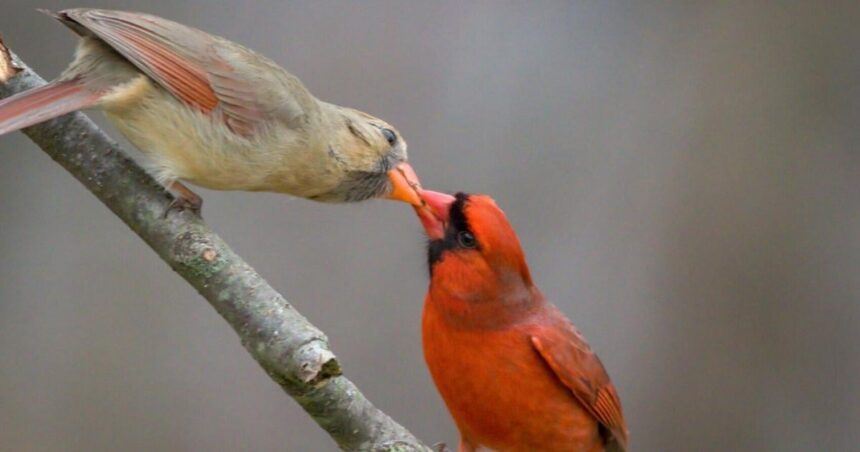I scatter a small amount of sunflower kernels on our patio daily. Over the past month, a male cardinal has been appearing near our patio sliding door multiple times a day. He makes sure to get our attention by flying around and approaching the door closely to ensure we see him.
I’ve noticed that he is often accompanied by a plump female. He frequently takes a kernel to her and feeds her, beak to beak. She trembles while he does this. She never feeds herself, and her shaking only occurs when he is feeding her. Is this behavior normal, and what does it indicate?
– Steve, Manhasset, New York
The male’s frequent visits and territorial displays near your back door are common behaviors during the breeding season. He is marking his territory. The act of the male feeding the female is a typical courtship behavior. By providing food, he strengthens their bond, allowing the female to conserve energy for egg-laying and incubation, ensuring successful breeding. The female’s shaking could indicate trust or excitement. Observing bird behaviors can be a delightful experience. Enjoy!
People are also reading…
We have three cats, all of which eat canned food twice daily. Dry food is available 24/7. One of them, a 13-year-old female, was missing from our home for a month. When she returned, the vet noted that she was severely underweight, weighing only 6.6 lbs compared to her initial 11 to 12 lbs. She was emaciated.
Three months later, she began begging for wet food six or eight times a day. As a soft-hearted owner and due to frequent vomiting of dry food, I often give in. It can be bothersome, but my love for her prevails. Do you have any insights into why she has turned into a bottomless pit?
— Jim, Tucson, Arizona
Following her prolonged absence and significant weight loss, it’s understandable that her behavior towards food has changed dramatically. There are several possible reasons for her increased appetite and aversion to dry food.
After enduring severe starvation, her body likely needs more nutrients and calories to recover lost weight and rebuild muscle, leading to what appears as insatiable hunger.
The stress of being lost and starved could have lasting effects on her eating habits. She might be overeating as a coping mechanism, driven by the fear of food scarcity. If she frequently vomits dry food, she may have developed an intolerance or sensitivity to it; trying a different brand or protein source might be beneficial.
At 13 years old, she could also be dealing with age-related health issues impacting her appetite. Conditions like hyperthyroidism and diabetes can cause increased hunger. It’s advisable to have her reexamined by a vet to rule out these possibilities.
If all is well medically, consider feeding her smaller, more frequent portions of wet food throughout the day to prevent excessive hunger and reduce strain on her digestive system. Additionally, easing her stress with a feline pheromone collar for 90 days could be helpful. Addressing both her physical and emotional needs can aid in her full recovery.
I came across the story of the owner struggling with her very senior cat incessantly yowling for food. At 15 years old, our cat started demanding food multiple times during the night. We invested in an automatic feeder powered by batteries (recharged via USB) that can be programmed to dispense food as needed.
Given that our cat prefers wet food, we were pleased to find that this model includes specially designed ice packs beneath the tray with 6 compartments. We portion about 2 tablespoons of wet food in each section and set it to open every 2 hours overnight.
Our cat quickly learned that the soft sound from the feeder meant fresh food. In the morning, we clean the tray and refreeze the ice packs for the next night. The outcome? A satiated cat and uninterrupted sleep for us. I hope this solution proves helpful!
– Michele, Williamson, Virginia
It’s wonderful to hear how you addressed your senior cat’s nighttime hunger with an automatic feeder. The inclusion of specially designed ice packs and programmable compartments make it an excellent choice. This setup sounds like an effective way to keep your cat content through the night without disrupting your rest. Thank you for sharing this solution.
(Cathy M. Rosenthal is a longtime animal advocate, author, columnist, and pet expert with over 25 years in the animal welfare field. Send your pet questions, stories, and tips to cathy@petpundit.com. Please include your name, city, and state. You can follow her @cathymrosenthal.)





